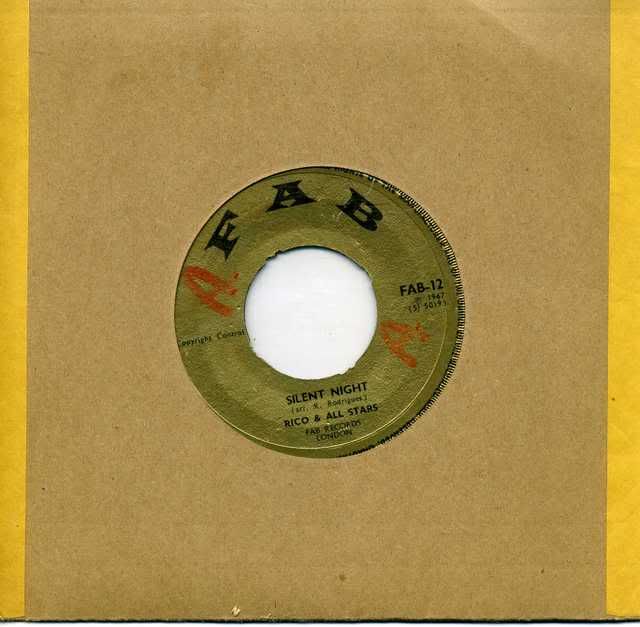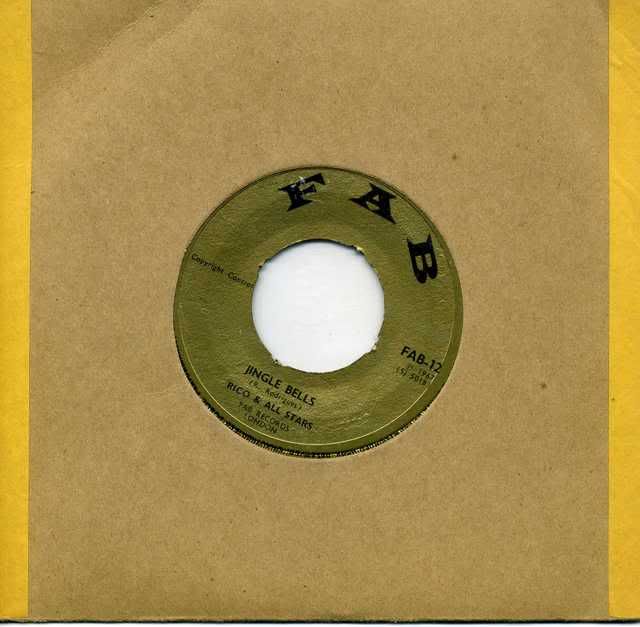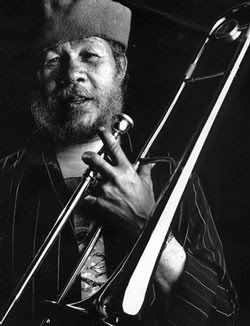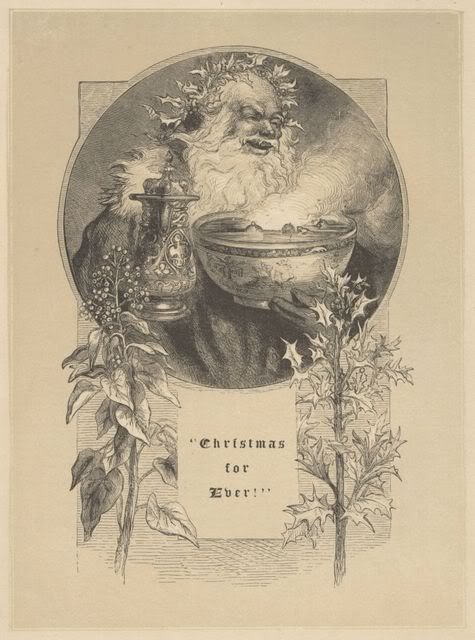

Not Rico’s best moment by far, but still a nice slice of christmas spirit 1967 reggae style.
Text from geocities.com.

Rico attended the Alpha Boys Cottage School in Kingston where he learned to play trombone. His tutor was another pupil of that school, two years older than Rico, the now legendary Don Drummond. Many of the other important musicians from the early days of Jamaican recorded music have been his school mates. Classical music was in the center of his timetable at this school.
His school education was followed by an apprenticeship as a mechanic during 1952 to 1954.
From 1954 to 1957 Rico continued his musical education at Stoney Hill Music School. During these years his musical influences were the two jazz trombonists J.J. Johnson and Kai Winding who released several common albums in those years.
Rico had his first studio engagements, among them (we think it was in 1956) Rico participated as a member of Clue J. And His Blues Blasters in C.S. Dodd’s very first session to record Easy Snappin’ with Theo Beckford.
During 1957 and 1958 Rico was playing three months with Eric Deans Orchestra, replacing Don Drummond (mostly in Latin and Cuban styles). He won at Vere John’s Opportunity Hour and thus built a name in the local music scene. Life was hard and it doesn’t wonder that Rico lived from hand to mouth. He had to play for food with the fishermen on the beach near Kingston. In Rico’s words: “Because you were poor and had to eat, you stay down where the fishermen draw their nets, so you’d have food every day. Fishermen always give you fish, they like to hear you playing.” (from an interview in 1973, quoted by Cane-Honeysett, 1995)
He spent much time in Count Ossie’s rasta community in Wareika Hills near Kingston. Percussionist and burru drummer Ossie teached Rico another side of music – Sheet music at school, jazz on the streets and African vibes over there in the hills -. Rico remembered his experience: “They’re more developed, mentally and musically, than the average musician. When you play with them you can really explore. Most of what I know I learned from playing with them.” (Williams 1981)
While he lived in the Rasta camp with Count Ossie in Wareika Hills, he worked at a barber’s shop in Kingston.
While the Jamaican recording industry changed and grew rapidly in the field of self-produced popular dance music, Rico got more and more involved as a sought-after session man. He went on recording with various session groups, namely Clue J & The Blues Blasters, Count Ossie’s Group, Smith All Stars, Drumbago And His Orchestra and for all the important producers – Clement Dodd, Duke Reid, Vincent Chin, <Lloyd Daley – and as Rico’s Group or All Stars for Prince Buster. Duke Reid (producing classics like Derrick Morgan’s “Lover Boy”) and Vincent Chin (Randy’s) engaged him for their very first recordings. While Rico helped at Randy’s, Chin produced Rico’s first sides under his own name: “Rico Special” and later “Rico Farewell”, the second as his goodbye to Jamaica and shortly after released in the UK by the young Island Records label.
At the end of 1961, at the age of 29, Rico emigrated to England.
Thanks to the imported Jamaican music on records Rico’s name was already known within the immigrant community in London when he arrived. Thus it was no problem to start recording for the same people: Importers like Emil Shallit, Siggy Jackson (Melodisc/Blue Beat) and others started to produce records in London. Rico’s first sessions were done already in 1962 by Planetone; at the same time he played the London club scene, for six month with Georgie Fame’s Blue Flames.
Clement Dodd remembered in an interview from 1994 that it was Rico who inspired the Beatles to let their hair grow. It is said, that the foursome attended a lot of West Indian parties where Rico played because “he really kicked up a storm”. (Hardbeatnews, 2004)
More and more singers came from Jamaica to London, composed a tour band and recorded in London studios. For instrumentalsts like Rico this meant work and it’s no surprise, that he can be heard on many records, e.g. on tracks by Prince Buster, one of the best tracks was “Barrister Pardon”.
Finally, in 1969 two LPs had been released with Rico as the featured artist: Reco in Reggaeland (on Pama), Blow Your Horn (Trojan) and another one with him as mayor soloist Brixton Cat, credited to Joe’s All Stars and released by Trojan.
Despite of being active in the music scene money was never enough. Occasional jobs and assembly-line working were necessary to earn a living.
Jamaican music had changed from ska to rock steady to reggae. Rico Rodriguez joined a group which is completely unknown today but was described by him as one of the most talented reggae bands in the UK: The Undivided lived as a backing band for Jamaican reggae artists touring the UK.
When Island Records re-entered the reggae market Rico came onto the list of session musicians for the fast growing enterprise. His first sessions took place in 1975 and were released as Toots’ Reggae Got Soul and Jim Capaldi’s (non-reggae album) Short Cut Draw Blood.
In the Island studios Rico met a man named Dick Cuthell, with whom he went together for a good seven years. Cuthell, an engineer on Island’s paylist, recorded a demo for Rico which opened the way to Rico’s first trip to Jamaica in 15 years and the seminal recording of Man From Wareika with some of the best Jamaican studio musicians; the release follows in 1977.
With an critically acclaimed sols album Rico was engaged as a support act for Bob Marley & The Wailers on his 1978 tour in Europe. Rico had a chance to play in front of audiences and to build his reputation towards the European public. Island prepared a new album for Rico, but tried to direct him towards a more easy listening style. Some 12” single had been released which were planned to become the core of this new album. Already given a catalogue number it was never released.
Meanwhile Rico had received a phone call by a certain Jerry Dammers, who looked for Rico to play with his band, The Specials a remake of “Rudi A Message To You”. The song was already recorded in two version by Rico, one for Dandy (Livingston) in 1967 and one credited to Rico himself from 1969. After the success of the Special’s music Rico (and Dick Cuthell) became associated members of the group, participating in their touring and recording activities. Rico played on the groundbreaking albums Specials and More Specials, he contributed to The Selecter’s debut.
“Despite the exposure he’d been given by working with The Specials, Island surprisingly did not renew his contract when it expired in January 1980, leaving him free to record for 2 Tone. They did make a half-hearted attempt to get The Specials to back Rico on a live take of “Guns Of Navarone” to be released on Island, but nothing came of it and so that it was.” (George Marshall, 1990, p. 65)
In 1980 Rico was going to release his first single “Sea Cruise” on the 2 Tone label. He toured with The Specials but left for Jamaica accompanied by Dick Cuthell where he was in the studio to record for his next LP That Man Is Forward. Later in 1980 Rico toured with his own band and on Dec. 21 he joined the Police in their concert for “So Lonely”.
In 1981 he played another great solo on the Specials’ last single “Ghost Town” maybe the best single of the 1980s and surely the best horn solo in pop history.
Ian Dury made him public to his audience while singing “… listening to Rico…” in his hit “Reasons To Be Cheerful, Pt.III)”. All these activities made him a central part of the 2 Tone story: he represented the Jamaican roots within The Specials’ and the other group’s music and made his instrument and his style attractive to the pop music market.

The history of a Christmas festival dates back over 4000 years. Ancient Midwinter festivities celebrated the return of the Sun from cold and darkness. Midwinter was a turning point between the Old Year and the New Year. Fire was a symbol of hope and boughs of greenery symbolized the eternal cycle of creation.
The term “Xmas” instead of “Christmas” is Greek in origin. The word for “Christ” in Greek is “Xristos.” during the Sixteenth Century, Europeans began using the first initial of Christ’s name…the “X” of “Xristos”…in place of the word “Christ” as a shorthand version of the word “Christmas.” Although early Christians understood that the “X” was simply another form for the name of Jesus Christ, later Christians, who had no knowledge of the Greek language, mistook “Xmas” as a sign of disrespect. Eventually, however, “Xmas” came to be both an accepted and suitable alternative to the word “Christmas.”
Many of today’s Christmas traditions were celebrated centuries before the Christ Child was born. The Twelve Days of Christmas, blazing fires, the yule log, the giving of gifts, carnivals or parades complete with floats, carolers who sing while going from house to house, holiday feasts and church processions are all rooted in the customs observed by early Mesopotamians.
Many of these traditions began with the Mesopotamian celebration of the New Year. The Mesopotamians worshipped many gods, the chief of whom was Marduk. Each year as winter arrived, it was believed that Marduk would battle the Monsters of Chaos. In order to assist Marduk during his struggle, the Mesopotamians held a festival for the New Year. They called this celebration Zagmuk and the festivities lasted for twelve days.
The King of Mesopotamia would return to the Temple of Marduk and swear his faithfulness to the god. The tradition called for the King to die at the end of the year and then return with Marduk to battle at his side. To spare their King, the Mesopotamians utilized a “mock” king. A criminal was chosen and dressed in royal clothes. He was given all due respect and the privileges of a true king but, at the end of the celebrations, the “mock” king was stripped of the royal garments and then put to death, thus sparing the life of the real monarch.
The ancient Persians and Babylonians celebrated a similar festival which they called the Sacaea. Part of that celebration included the exchanging of places within the community…slaves would become masters and the original masters were obliged to obey the former slaves’ commands.
In Scandinavia during the winter months, the Sun would disappear for great lengths of time. After thirty-five of such dark days, scouts would be dispatched to the mountain tops to await the return of this life-giving heavenly body. When the first light was espied, the scouts would hurry back to their villages bearing the good news. In celebration, a great festival would be held, called the Yuletide, and a special feast would be served around a fire burning with the Yule log. Huge bonfires would also be lit to celebrate the welcome return of the Sun. In some areas, people would tie apples to the branches of trees as a reminder that Spring and Summer would eventually return.
The ancient Greeks held ceremonies similar to those of the Zagmuk and Sacaea festivals. The purpose of this feast was to assist their god Kronos, who would battle against the god Zeus and his army of Titans.
Members of the pagan order have always celebrated the Winter Solstice…the season of the year when days are shortest and nights longest. It was generally believed to be a time of drunkenness, revelry and debauchery. The pagan Romans called this celebration Saturnalia, in honor of their god Saturn. The festivities began in the middle of December and continued until January 1st. On December 25th, “The Birth of the Unconquerable Sun” was celebrated, as the days gradually lengthened and the Sun began to regain its dominance. It is a general pagan belief that the Sun dies during the Winter Solstice and then rises from the dead. With cries of “Jo Saturnalia!”, the Roman celebration would include masquerades in the streets, mangificent festive banquets, the visiting of friends and the exchange of good-luck gifts known as Strenae…or “lucky fruits.” Roman halls would be decked with garlands of laurel and green trees, adorned with lighted candles. Again, as with Sacaea, the masters and slaves would exchange places.
Saturnalia was considered a fun and festive time for the Romans, but Christians believed it an abomination to honor such a pagan god. The early converts wanted to maintain the birthday of their Christ Child as a solemn and religious holiday…not one of cheer and merriment, as was the pagan celebration of Saturnalia.
As Christianity spread, however, the Church became alarmed by the continuing practice among its flock to indulge in pagan customs and celebrate the festival of Saturnalia. At first, the holy men prohibited this type of revelry, but it was to no avail. Eventually, a decision was made to tame such celebrations and make them into a festive occasion better suited to honor the Christian Son of God.
According to some legends, the Christian celebration of Christmas was invented to compete against the pagan festivals held in December. The 25th was sacred not only to the Romans, but also to the Persians whose religion of Mithraism was one of Christianity’s main rivals at that period in time. The Church was, however, finally successful in removing the merriment, lights and gifts from the Saturanilia festival and transferring them to the celebration of a Christian Christmas.
Christmas means “Christ’s Mass” and is the celebration of Jesus Christ’s birth and baptism. Although December 25th is generally accepted as being the time when the Christ Child was born, the exact date has never been chronicled with any degree of accuracy. There is neither scriptural nor secular evidence to establish the exact moment. One thing is relatively certain, however, the event did not take place in December. Since the child was born when shepherds were “abiding in the field, keeping watch over their flocks by night” (Luke 2:8), it is unlikely that shepherds in Israel would have been sleeping outside with their flocks during the month of December. In Winter, the herders would have led their sheep outside only during the daylight hours…the nights would have been far too cold. It is known that during the very early Christian centuries, the birth of the Christ Child was not celebrated in any manner. However, tradition dictates that the occasion has been commemorated since 98 A.D. In 137 A.D., the Bishop of Rome ordered that the birthday of Jesus Christ be observed as a solemn feast. In 350 A.D., Julius I (another Bishop of Rome) selected December 25th as the observance of Christmas. This date was made official in 375 A.D., when it was formally announced that the birth of Jesus would be honored on this day…the announcement also allowed some of the older festivies (such as feasting, dancing and the exchange of gifts) to be incorporated into the observance of Christmas. The use of greenery to decorate homes continued to be prohibited as pagan idolatory but, over the centuries, this too became an accepted custom of the festivies.
HOPING YOU ALL HAVE AN ENJOYABLE AND SAFE CHRISTMAS
All the best from Tony D, Gerard, Alistair and Penguin x
kperry
December 26, 2008 at 2:28 amMany happy days to come . Thanks for the great blog this past year and hope for more in the hopefully better times new year
cheers and a toast to you and yours
The Punk / Post Punk Tribe
December 27, 2008 at 9:41 amSame for you!
Carl
December 27, 2008 at 7:22 pmSame for you chaps..
Web site is brilliant, revived stuff i’ve long forgotten about.
Thanks.
Stewart
December 27, 2008 at 9:37 pmBah, humbug… But a toast to the survivors anyway 🙂 x
Kerr Ray Z. Fokker
December 1, 2010 at 7:40 pmCan you re-upload jingle bells please?
Penguin • Post Author •
December 2, 2010 at 12:58 amDone now Kerr, dunno what happened to media fire there! All good now though.
Kerr Ray Z. Fokker
December 2, 2010 at 11:05 amThanks, Mr Penguin.
Fingers crossed (weather etc), I am going to a seriously bombastic bluebeat/rocksteady bash at my local West Indian dominoes club in a couple of weeks. This will help get me in the mood.